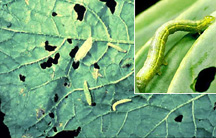
Chesapeake Bay's Independent Newspaper ~ Since 1993
1629 Forest Drive, Annapolis, MD 21403 • 410-626-9888
Volume XVII, Issue 44 ~ October 29 - November 4, 2009
Home \\ Correspondence \\ from the Editor \\ Submit a Letter \\ Classifieds \\ Contact Us
Dining Guide \\ Home & Garden Guide \\ Archives \\ Distribution Locations \\ Advertising
![]()

|
The Bay Gardener
 by Dr. Frank Gouin |
Fall Gardens Feed Us Well
Vegetables are sweeter (and the bugs think so, too)
The cool September and October we’ve enjoyed have been ideal for growing cabbage, cauliflower, broccoli, Brussels sprouts, lettuce, kohlrabi, peas, beans, carrots, beets, turnips and rutabaga. These crops grow best when we have warm days and cool nights.
Fall growth-cabbage is often best for making sauerkraut. It is easy to make, and within six to eight weeks you will be enjoying the best sauerkraut you have ever eaten.
Fall is also the best time for growing cauliflower and Brussels sprouts. I also prefer eating fall-grown broccoli because it tends to be sweeter and more tender than spring-grown broccoli. Kohlrabi grown in the fall remains edible longer than kohlrabi grown in the spring because as daylight hours grow shorter and temperatures cool, the plant growth slows down. Turnips and rutabaga are also better when grown in the fall. Collard greens and kale are at their best after they have been frosted a couple of times. Research has documented that all these crops are good for you.

 But Watch Out for Cabbage Loopers
But Watch Out for Cabbage Loopers
But cabbage loopers will get to your vegetables unless you keep a sharp eye out. Observe your garden during the day. If you see white or pale yellow butterflies flirting with the plants in your garden, you can bet that they are laying their eggs. These eggs will hatch, and small green worms, up to one inch long, will be feeding on your plants. Their presence can be detected on the leaves, where they eat irregular holes. If the population is allowed to grow, they will consume all of the soft tissues between the leaf veins.
Daily observations of the garden will determine your need to spray. If you see cabbage-looper moths flying in your garden, spray weekly with a biologically safe insecticide called Bt, sold under the trade name of Dipel or Thuracide. A single application of either of these sprays will provide a week of control. Thoroughly cover the plants, spraying both sides of each row, forward and back.
The cabbage-looper moths will disappear as soon as the gardens experience a frost. However, if your plants are infested with loopers, you will need to spray them at least one more time after the first frost. The larvae are protected from the frost by the foliage and the bulk of the plants they are feeding on.
Sauerkraut a la Bay Gardener
Start with finely chopped fresh cabbage. For every five pounds of cabbage, add three tablespoons of salt. Spread the chopped cabbage uniformly on the bottom of a tight, clean crock and sprinkle the salt over the cabbage. Using a wooden stick 18 to 24 inches long and two to three inches in diameter, pound the salt into the cabbage until you hear the juices beginning to separate from the chopped cabbage. When each punch of the stick sound sloppy wet, add another layer of cabbage and salt and pound some more. By now, you should begin seeing the juices start flooding the cabbage. By the time you have pounded 15 pounds of cabbage, the juices should be covering the cabbage.
I generally make 15 to 20 pounds of sauerkraut each year, enough to fill a three-gallon crock. Some years I have made up to 40 pounds, using a five-gallon crock.
For the chopped cabbage to ferment, you need to create an air-lock that will prevent oxygen from entering and allow the carbon dioxide to escape. This is done by placing a dinner plate, face up, over the chopped and pounded cabbage with the juice slightly covering the plate. Over the plate, lay flat-side-down a two-gallon zipped plastic bag filled half-full with water. Cover the crock to keep dust and dirt out.
Place the crock in a cool place and allow it to ferment for six to eight weeks for a nice, white sauerkraut.
When you open the crock you will find that the kraut between the edge of the dinner plate and the walls of the crock will be discolored.
Remove the plate and, with a large, strong spoon, remove and discard the discolored layer. The sauerkraut can either be canned or placed in plastic bags and frozen.
Ask Dr. Gouin your questions at [email protected]. All questions will appear in Bay Weekly. Please include your name and address.
© COPYRIGHT 2009 by New Bay Enterprises, Inc. All rights reserved.